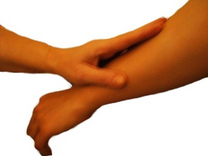I get a lot of questions about MRT so let me share with you how I found out about this incredible assessment tool. I first learned of MRT at a Christian ministry in Colorado Springs called Health Quarters Ministries. It was such an amazing experience to realize that God gave us the ability to find out more about our bodies with such a simple tool as MRT, something the Chinese have been using for thousands of years. After learning about this valuable tool, I attended the Trinity School of Natural Health (a Christian organization focusing on Naturopathy, Iridology, and all forms of natural health). I became certifed as a Nutritional Consultant as well as a Health Specialist, specializing in MRT as one of the many assessment tools used in natural health. I utilize MRT everyday, whether testing supplements for my son or certain food or beauty products on myself. I can test to see if the body reacts in a positive or negative way as well as any deficiencies that may exist in the system. Utilizing MRT, I am also able to test for hundreds of food allergies and intolerances. Please take some time to read the information below and learn more about this incredible tool. If you would like to see what deficiencies your body may have, click here to schedule a consultation, or find out more about the services I offer. I look forward to helping you on your path to health!
Who Uses MRT or Muscle Response Testing?
Muscle Response Testing is a diagnostic technique that is valuable to many procedures and treatments. It is a viable, efficient and effective tool for determining the body’s needs. MRT is currently being used by many healing disciplines: medical doctors, acupuncturists, chiropractors, naturopaths, osteopaths, holistic dentists, veterinarians and other practitioners. In fact many books have been written on MRT.
Who Developed Muscle Testing?
Muscle testing was developed in l964 by Dr.George Goodheart, DC, a Chiropractor. He developed a diagnostic system called Applied Kinesiology, which allowed muscles to be tested for clinical and diagnostic purposes, not just to determine muscle strength. Applied Kinesiology was derived from the ancient art of Acupuncture, which was developed by the Chinese between 3000 and 25 BC.
How It Is Done?
The practitioner gently pushes down on the patient’s extended arm which is resisting the downward pressure. If we irritate the nervous system for a second, it will cause a temporary short circuit causing the testing arm to momentarily go weak. We can irritate the nervous system by touching a sensitive area on the body, a weakened reflex, acupuncture point or even by an uncomfortable or irritating thought. One of the most valuable uses of the muscle test is to ask “yes/no” questions of the nervous system, looking for a weak or strong response. This reveals information about troubled areas in the body and how to treat them.
How Does It Work?
When our body’s energy system processes a stimulus , there are thousands of instant reactions going on in the nervous system on a cellular and tissue level. Many of these are observable. Like the questions asked in a lie detector test, our heart rate may increase or decrease, our breathing rate may be altered, our pulse can change, our digestion may be effected, our skin texture will change (sweat/clammy) and muscles may get momentarily weaker or stronger.
It is our muscle response that we will pay attention to for an indicator to measure a response, reaction or state of being in the body/mind.
When the body/mind’s bio computer is momentarily focused on an irritation or imbalance in its system, our muscles seem to momentarily weaken or contract. This is not noticed in our everyday lives. However, if we were to test the strength of a muscle with MRT, we would notice a momentary weakness. It is almost as if the nervous system short circuits the muscle for a second. It is this momentary weakness that gives us our information.
What Can It Be Used For?
It is now determined that muscle testing can be used for virtually any question that can be asked of the body to make determinations about physiology, skeletal trauma, allergies, nutritional imbalances, emotional states or anything that can affect body or mind etc. This diagnostic tool is only limited to the creativity of the practitioner’s ability to ask the proper questions. Once the information is ascertained, muscle testing can then be used to find out what the body or mind will respond to in terms of a resolution to the problem.
This breakthrough allows us to obtain information about weaknesses in the body that were previously unavailable. Hidden problems that would have remained undetected until they became chronic problems could be seen in advance and treated quickly.
Another important benefit of MRT is that many of these problems fall under the radar of conventional lab and exam tests and are not discovered at all except with the benefit of MRT. *Courtesy of Health Quarters Ministries
